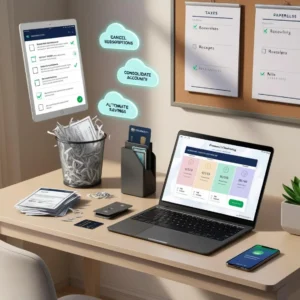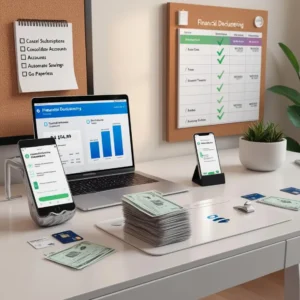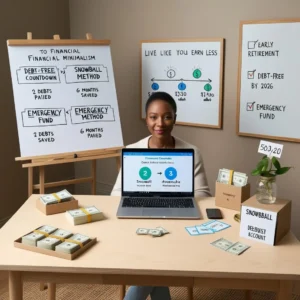What is Financial Minimalism?
Financial minimalism is a mindful approach to money management that focuses on simplifying your financial life, cutting out unnecessary expenses, and prioritizing financial well-being. It aligns closely with the principles of minimalism, encouraging people to declutter not only their physical spaces but also their finances.
Key aspects of financial minimalism include:
- Intentional spending: Prioritizing purchases that align with your values and long-term goals.
- Reducing financial complexity: Minimizing bank accounts, credit cards, and financial obligations.
- Avoiding lifestyle inflation: Resisting the urge to spend more as income increases.
- Prioritizing savings and investments: Ensuring money is working for you rather than being wasted on non-essential expenses.
By adopting financial minimalism, you can experience less financial stress, more freedom, and a clearer path to financial independence.
The Connection Between Simple Living and Financial Freedom
Financial minimalism and simple living go hand in hand. A minimalist lifestyle naturally reduces financial pressure by eliminating unnecessary expenses and focusing on what truly adds value.
Consider these examples of how minimalism leads to financial independence:
- Digital nomads and tiny house owners: Many people who embrace a minimalist lifestyle downsize their living space and possessions, reducing expenses and allowing them to work less while enjoying life more.
- The FIRE (Financial Independence, Retire Early) movement: Many early retirees achieve financial freedom by keeping their lifestyle simple, saving aggressively, and avoiding unnecessary spending.
- Minimalist entrepreneurs: Some business owners adopt financial minimalism by running lean, avoiding debt, and prioritizing essential investments rather than chasing luxury.
Living simply allows for greater financial flexibility, fewer money worries, and more opportunities to pursue meaningful experiences rather than material goods.
Why Financial Minimalism Matters Today
We live in a world of consumerism, digital distractions, and financial stress. Financial minimalism helps counteract these challenges:
- Rising consumer debt: Many people struggle with high-interest credit card debt, student loans, and personal loans, making financial minimalism more important than ever.
- Subscription overload: With streaming services, software subscriptions, and memberships, it’s easy to waste money without realizing it.
- Social media-driven spending: Platforms like Instagram and TikTok promote trends that encourage people to spend on unnecessary items to keep up with appearances.
- Financial complexity: Managing multiple accounts, credit cards, and financial obligations can be overwhelming and stressful.
By simplifying your financial life, you reduce stress, increase savings, and gain better control over your money.

1. The Core Principles of Financial Minimalism
Spending with Intention
Intentional spending means making deliberate choices about how you use your money. Instead of impulse buying, financial minimalists focus on purchases that truly enhance their lives.
Tips for mindful spending:
- Use a “wait 48 hours” rule before making non-essential purchases.
- Keep a “wish list” instead of buying things immediately.
- Prioritize experiences over material goods.
- Ask yourself: Does this purchase align with my values and goals?
Decluttering Your Financial Life
Financial clutter can take many forms: too many credit cards, unnecessary accounts, forgotten subscriptions, and excessive debt. Financial minimalists cut out the excess and streamline their financial system.
Ways to declutter finances:
- Cancel unused subscriptions.
- Close redundant bank accounts and consolidate finances.
- Reduce credit card usage to one or two essential cards.
- Simplify investment accounts to avoid overcomplication.
Living Below Your Means
Living below your means is the foundation of financial freedom. It allows you to save more, invest wisely, and avoid financial stress.
Ways to live below your means:
- Avoid lifestyle inflation—when income increases, keep expenses the same.
- Buy quality over quantity—invest in durable items instead of cheap, disposable ones.
- Opt for minimal housing and transportation costs—these are the biggest expenses for most people.
- Cook at home instead of eating out frequently.
Prioritizing Value Over Cost
Many people focus on cheap prices rather than long-term value. However, financial minimalism encourages investing in quality, saving money in the long run.
For example:
- A $300 high-quality coat that lasts 10 years is better than buying a $50 coat every year.
- A durable, energy-efficient appliance may have a higher upfront cost but saves money on repairs and energy bills.
- A well-made laptop or phone lasts longer, reducing the need for frequent replacements.

2. How to Declutter Your Finances
Eliminating Unnecessary Subscriptions & Expenses
Subscription services can drain your finances without you even noticing. To cut back:
- Review bank statements to identify recurring charges.
- Cancel anything you don’t use regularly.
- Use free or lower-cost alternatives (e.g., switch from cable TV to free streaming services).
Consolidating Bank Accounts and Credit Cards
Having multiple accounts creates unnecessary financial clutter. Reduce the number of:
- Checking and savings accounts (stick to one main account).
- Credit cards (choose one or two with the best rewards).
- Investment accounts (consolidate for easier tracking).
Automating Payments and Savings
Automation removes the stress of manual money management. Set up automatic:
- Bill payments (to avoid late fees).
- Savings transfers (so you “pay yourself first”).
- Debt payments (to stay on track with repayment).
Digital Decluttering: Organizing Financial Documents
Keeping physical financial documents is outdated. Instead, digitize everything:

- Use cloud storage for receipts and tax documents.
- Switch to paperless billing.
- Keep a minimalist financial folder system for important records.
3. Building a Minimalist Budget
The Zero-Based Budgeting Approach
Zero-based budgeting ensures every dollar is accounted for. Instead of leaving money unallocated, assign each dollar to a specific category (bills, savings, investments, etc.).
Steps to create a zero-based budget:
- Calculate total income.
- List all expenses and assign every dollar a purpose.
- Adjust until income minus expenses equals zero.
The 50/30/20 Rule: A Minimalist’s Perspective
A simple budgeting framework that financial minimalists love is the 50/30/20 rule:
- 50% for needs (rent, utilities, groceries).
- 30% for wants (entertainment, travel, hobbies).
- 20% for savings and debt repayment.
This method prevents overcomplication while ensuring financial balance.
Tracking Expenses Without Overcomplicating
Tracking expenses doesn’t have to be overwhelming. Minimalists use simple methods:
- Set category spending limits rather than tracking every dollar.
- Use a single money management app instead of multiple budgeting tools.
- Check bank statements weekly to monitor spending patterns.
By adopting financial minimalism, you create a stress-free financial system, eliminate wasteful spending, and focus on what truly matters. Whether you want to reduce debt, save more, or simplify your financial life, financial minimalism helps you gain clarity, control, and peace of mind.
4. Essential Money Management Apps for Financial Minimalists
Best Budgeting Apps to Keep It Simple

Minimalist budgeting doesn’t require complicated spreadsheets or detailed tracking. The best budgeting apps are simple, intuitive, and require minimal effort.
Top budgeting apps for financial minimalists:
- YNAB (You Need a Budget) – Best for zero-based budgeting, ensuring every dollar has a purpose.
- Mint – A free app that tracks spending, categorizes expenses, and provides budget insights.
- PocketGuard – Helps users see how much money they can safely spend after bills and savings.
Expense Tracking Without Overwhelm
Tracking expenses doesn’t mean monitoring every penny. Instead, focus on broad categories and general spending habits.
- Use apps that automatically categorize spending so you don’t have to manually input transactions.
- Set up spending alerts to notify you when you go over budget.
- Review your spending weekly or monthly, rather than daily, to avoid micromanaging.
Automating Savings for Effortless Growth
Automation is a core principle of financial minimalism. It removes the stress of manual money management while ensuring you consistently build wealth.
Apps that automate savings effortlessly:
- Acorns – Rounds up your purchases and invests the spare change.
- Digit – Analyzes spending habits and automatically saves small amounts based on what you can afford.
- Chime – Automatically transfers a percentage of your income into savings.
By automating your savings, you make wealth-building a habit without even thinking about it.
5. Financial Minimalism and Debt-Free Living
Paying Off Debt with a Minimalist Mindset
A minimalist approach to debt focuses on eliminating unnecessary expenses and aggressively paying off balances.
Steps to become debt-free faster:
- Cut out non-essential spending. Redirect money toward debt payments.
- Use the “Snowball” or “Avalanche” method.
- Snowball Method: Pay off small debts first to gain momentum.
- Avalanche Method: Pay off high-interest debts first to save the most money.
- Downsize and sell unused items. Put the extra money toward debt repayment.
Strategies for Avoiding Lifestyle Inflation
Lifestyle inflation happens when spending rises alongside income. To avoid it:
- Continue living as if you earn less. Instead of upgrading your lifestyle with each raise, put the extra money into investments or savings.
- Set clear financial goals. Having a plan for your money (early retirement, home ownership, travel) helps resist unnecessary spending.
- Use percentage-based budgeting. Stick to the 50/30/20 rule even as income grows.
Emergency Funds: Keeping It Simple and Effective

An emergency fund prevents financial setbacks. How much should you save?
- Minimum: 3 months of essential expenses.
- Ideal: 6–12 months, especially if you have variable income.
Where to keep it:
- High-yield savings accounts for easy access and interest earnings.
- Separate account from daily spending to avoid accidental use.
6. Sustainable Financial Habits for Long-Term Success
Practicing Conscious Spending
Mindful spending ensures money is used wisely. To build this habit:
- Unsubscribe from marketing emails to reduce impulse buying.
- Use cash or debit for discretionary spending to avoid debt.
- Reflect on past purchases. Ask yourself if they truly added value to your life.
Creating a Minimalist Investment Strategy
Investing doesn’t need to be complicated. Minimalists favor simple, low-cost, and long-term investment strategies.
Best approaches for minimalist investing:
- Index funds (e.g., S&P 500 ETFs) – Low-cost, diversified, and hands-off.
- Automated investing (e.g., robo-advisors like Betterment) – Hands-free investing for beginners.
- Dollar-cost averaging – Invest the same amount regularly, regardless of market fluctuations.
Aligning Financial Goals with Personal Values
Your money should reflect what’s most important to you. Instead of chasing arbitrary financial milestones, focus on values-based financial planning:
- If you value freedom, aim for financial independence through aggressive savings.
- If you value security, build strong emergency funds and retirement savings.
- If you value giving back, incorporate charitable donations or impact investing.
By aligning your finances with your values, you create a meaningful and fulfilling financial journey.

7. Conclusion
The Long-Term Benefits of Financial Minimalism
Financial minimalism leads to:
- Less stress and anxiety from financial clutter.
- More financial security through mindful spending and saving.
- Greater freedom to pursue passions, experiences, and life goals.
Taking the First Step Toward a Simpler Financial Life
Ready to start? Follow these actionable steps:
- Review your finances and eliminate unnecessary expenses.
- Simplify banking and credit accounts.
- Automate savings and debt payments.
- Practice mindful spending and focus on value.
- Set long-term financial goals aligned with your values.
By embracing financial minimalism, you gain clarity, control, and financial peace of mind—leading to a simpler, richer life.

